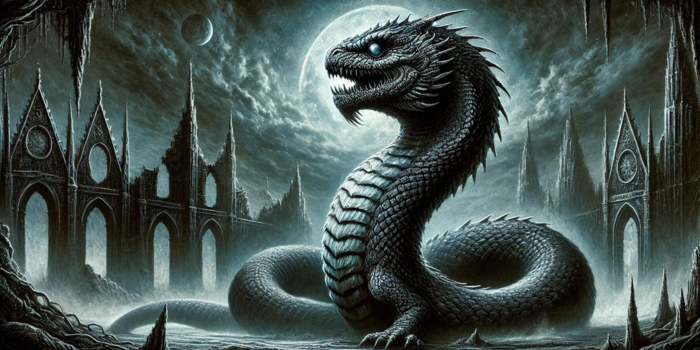
Basilisk's Influence on Danger, Death, and Transformation
|
|
Time to read 7 min
|
|
Time to read 7 min
The Basilisk, often referred to as the "King of Serpents," is a fearsome creature from European mythology and folklore. Known for its lethal gaze and poisonous breath, the Basilisk embodies themes of death, danger, and destruction. Its origins and mythological tales have been a source of fascination and fear for centuries, symbolizing the ultimate peril and the power of nature's deadliest forces.
Unlock the Mysteries of the Ars Goetia with a Free Oracle Tarot Reading , performed by the most experienced masters of Terra Incognita . This powerful reading is not a game—it is a serious and profound spiritual tool designed to provide clarity, guidance, and transformation. Only sincere requests are taken into consideration, ensuring that each reading is handled with the utmost dedication and expertise. Your personalized results will be delivered within 48 hours , offering you the wisdom and insight you seek.
👉 Submit your request here: Free Ars Goetia Oracle Tarot Reading
Are you ready to uncover the answers hidden within the shadows?
Connecting with the Basilisk involves understanding its lethal and mysterious nature. To attune to this powerful entity, one might:
Connecting with the Basilisk requires a recognition of the balance between power and caution. Practitioners might also engage in activities that emphasize protection and preparedness, such as learning self-defense, studying toxicology, or engaging in strategic planning exercises.
The Basilisk is often associated with the planet Saturn. Saturn, known for its connection to discipline, boundaries, and the passage of time, mirrors the Basilisk's themes of danger and mortality. This planetary association underscores the need for caution, responsibility, and respect for natural limits, highlighting the Basilisk's role as a symbol of ultimate peril.
Lead is the metal most closely linked to the Basilisk. Known for its dense and protective properties, lead symbolizes containment, shielding, and endurance. Using lead items in rituals, such as lead amulets or containers, can help strengthen the connection to the Basilisk. Additionally, lead's historical use in alchemy underscores its significance in transforming and neutralizing dangerous substances.
The element of the Basilisk is Earth, representing its connection to the ground and its deadly presence. Earth symbolizes both life and decay, aligning with the Basilisk's ability to bring death and destruction. Earth rituals, such as burying protective talismans or using clay and soil in ceremonies, are ways to honor the Basilisk and invoke its energy. The stabilizing and grounding properties of earth also mirror the Basilisk's role as a force of nature.
The Basilisk is associated with the astrological sign of Capricorn. Capricorn, ruled by Saturn, shares the Basilisk's attributes of discipline, caution, and resilience. The determined and strategic nature of Capricorn aligns with the Basilisk's spirit and its role as a formidable and calculated force. Capricorn's connection to boundaries and structure also reflects the Basilisk's ability to enforce limits and demand respect.
Offerings to the Basilisk can include:
These offerings not only honor the Basilisk but also invite its presence and blessings into one's life. Engaging in acts of protection and vigilance can be a powerful way to connect with its formidable energy.
The Basilisk shares relationships with several other figures in mythology and folklore:
The Basilisk has been a significant figure in various cultures, influencing folklore, art, and literature. It is often depicted in medieval manuscripts, paintings, and carvings as a symbol of ultimate danger and the embodiment of lethal power. The Basilisk's story has inspired numerous adaptations and interpretations, reflecting its enduring appeal and complexity. In modern culture, the term "basilisk" has come to symbolize something incredibly powerful and dangerous, often used metaphorically to describe overwhelming challenges.
The Basilisk has appeared in various movies and TV shows, often depicted as a terrifying and deadly creature. Notable portrayals include:
The Basilisk is a prominent figure in literature, especially in works exploring medieval myths and fantasy themes. Noteworthy mentions include:
Despite its significant role, several misconceptions surround the Basilisk:
Demon and Spirit Attunements, Amulets, and Grimoires are potent spiritual tools crafted to align your energy with powerful entities, offering protection, guidance, and healing. These sacred items bridge the gap between the earthly and spiritual realms, enabling you to connect with higher forces for clarity, empowerment, and inner strength. By wearing a demon or spirit amulet or engaging with a grimoire, you invite these potent energies into your life, providing ongoing support and shielding against negativity.
Demon and Spirit Attunements work to fine-tune your spiritual vibrations, enhancing your connection with specific entities and boosting your intuitive abilities. These practices create a comprehensive spiritual approach that not only protects you from harm but also opens pathways to profound transformation, spiritual growth, and inner wisdom. Through these tools, you harness the ancient powers of demons and spirits, forging a path toward deeper understanding and personal empowerment.